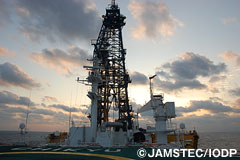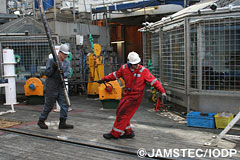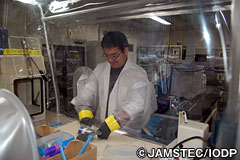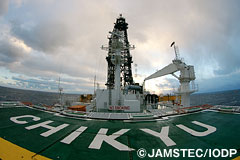
Weekly report #6-7
2008.2.5
IODP NanTroSEIZE Stage 1:
Expedition 316: NanTroSEIZE "Shallow Megasplay and Frontal Thrusts"
Weekly Report #6-7 (Final report)
Date 5/Feb/2008
D/V Chikyu relocated to Site C0008 (proposed site NT2-10A) on January 26th, 2008. The Remotely Operated Vehicle (ROV) was launched in order to deploy seafloor transponders below the Kuroshio Current (running at 2.0-2.5 knots at the time), and the Hydraulic Piston Coring System (HPCS)/Extended Shoe Coring System (ESCS) Borehole Assembly (BHA) was rigged up and readied while the vessel was calibrating for Dynamic Positioning System (DPS) navigation and positioning over the site. The BHA was run to the seafloor, the ROV launched, position checked, and Hole C0008A was tagged at 1:30 AM on January 27th at a depth of 2751 meter below sea floor (mbsf), at location 33°12.8229’N, 136°43.5997’E.
The first core (316-C0008A-1H) was a successful mudline core that penetrated to 6.93 mbsf with 100% recovery. Cores 316-C0008A-2H to -28H, -29X to -42X, and -43H were collected with a total of 6.93 meters of recovery at a rate of 75.8% in interlayered mud, silt and sand. Near the bottom of the hole, starting from Core 316-C0008A-34X the drilling rate of penetration dramatically increased and recovery dropped to near 0%. After several repeated attempts to improve recovery by changing drilling and pumping parameters, and a final attempt to successfully Hydraulic Piston Coring System (HPCS) core the inferred unconsolidated sand at the bottom of Hole C0008A, the hole was abandoned. During this time, a request was made to CDEX and EPSP (Environmental Protection and Safety Panel) to shift 215 meters South East and core Site C0008, Hole B. This request was approved.
POOH (pull out of hole) and completing the Hole C0008A took place between 9:00 AM and 18:15 PM on January 31, 2008. The BHA was POOH to 200 meters above the seafloor and the rig was shifted to Hole C0008B between 18:15 and 19:30 PM on January 31, 2008. Table C0008-B-1 shows the cores collected, meters recovered, and recovery percentage for holes C0008A. The vessel was positioned above Hole C0008B (C0008C is at the same location) at 21:30 PM, January 31, 2008; Latitude 33°12.7313’N, Longitude 136°43.6727’E, water depth 2797 meters below seafloor. The BHA was RIH (run in hole) to the seafloor, and the seafloor was tagged at 2828 meter below rotary table (mBRT). The first HPCS core (316-C0008B-1H) was shot at 21:35 PM, but did not successfully capture the mudline, Hole C0008B was abandoned and Core 316-C0008C-1H (5.51 meters of recovery, successful mudline) was shot in Hole C0008C at 0:05 AM on February 1, 2008. Coring operations in Hole C0008C resulted in the collection of cores 316-C0008C-1H to -21H, -22X, and 23X* to 25X* (0 - 176.2 mbsf) with total recovery of 189.7 meters of core and recovery rate of 108%.
During this operation, observations from previous Hole C0008A were used to adjust the determination of the advance of the piston core based on the drillers' information and the observation of large amounts of exotic material sucked into the bottoms of HPCS cores deeper in the section (316-C0008C-7H to -21H). This phenomenon resulted in initial recovery rates that in some cases exceeded 200 percent (i.e. with an advance of 5 meters and recovery of 10.2 meters). However, X-CT imagery and visual core description have confirmed that the drillers' advance data is a generally reliable measure of actual HPCS penetration. The intervals of each core occupied by exotic material pulled into the core bottom have been recorded, and use of the J-CORES depth processing and "D-Tunes" functionality will allow post-processing of the coring recovery and data registration with little difficulty.
After HPCS refusal was determined based on low-penetration, severe core liner deformation, and severe core expansion problems in Cores 316-C0008C-17H to -21H, the Extended Shoe Coring System (ESCS) was employed. However, the first ESCS core (316-C0008C-22X) was not of sufficient quality to justify further coring (preservation of the unconsolidated portions of the lithologic section and gas hydrates were particularly poor). The scientific goals of this site were deemed to have been accomplished, Target depth (TD) was declared and the newly developed ESCS "punch" coring system was deployed for testing. Three cores (316-C0008C-23X* to -25X*) were collected with this system with excellent results. A post-expedition report of the results of this coring system test, including X-CT scan, VCD, and chemistry data (for contamination analysis) will be produced to supplement this report.
Following collection of the final ESCS "punch" core at 20:35 PM on February 2, 2008, Hole C0008C was abandoned, the hole completed, and the BHA POOH to the surface. The BHA was recovered at 5:30 AM on February 3, 2008. The BHA was rigged down, excess drill pipe laid out, and the guidehorn rigged down. Transponders were recovered on the morning of February 4, 2008 and D/V Chikyu began transit to Shingu, Wakayama Prefecture, Japan.
Sampling for pore fluids, void gas (where appropriate), and head space gas was carried out in the core cutting area. XCT scanning, Multi-sensor core logging, and whole-round core sampling for geotechnical and physical properties analysis were carried out on whole round core sections, followed by core description (structural, sedimentological, stratigraphic), and physical properties measurements (thermal conductivity, moisture and density, P-wave velocity and electrical resistivity) were carried out on the split core section. This was followed by collection of a complete suite of samples for paleomagnetic, physical properties, paleontological, mineralogical, age-dating, geotechnical, and structural analyses. Following color and spectral scanning and paleomagnetic scanning, cores were packed for shipping to the core repository.
The weekly report about the Expedition 316 was reported by the Co-Chief Scientists (Dr. Elizabeth Screaton and Dr. Gaku Kimura), CDEX Operations Superintendent (Mr. Ikuo Sawada and Tsuyoshi Abe) and CDEX Expedition Project Manager (Dr. Daniel Curewitz).

Weekly report #5
2008.1.25
IODP NanTroSEIZE Stage 1:
Expedition 316: NanTroSEIZE "Shallow Megasplay and Frontal Thrusts"
Weekly Report #5
Date 25/Jan/2008
Piston core jamming required abandoning Hole C0007C, pull out and recovery of borehole assembly (BHA) took place between 12:00 and 24:00 PM on January 18, 2008. During this operation, request for permission to drill an alternate hole at a distance of 185 meters NW of C0007C was made, and permission was granted via CDEX and IODP Environmental Protection and Safety Panel (EPSP). Due to consideration of both science target and time requirements, decision was made to run the RCB coring system. The BHA was made up and run in the hole, and Hole C0007D was spudded on January 19, 2008 at 3:30 AM, water depth 2049 meter, Lat: 33°1.3167’N, Lon: 136°47.8872’E.
We conducted jet-in and wash down to 18 meter below seafloor (mbsf), and drilled down to 175 mbsf to the first coring point, which was reached at 00:00 AM on January 20th. Coring operations in Hole C0007D resulted in the collection of cores 316-C0007D-1R to -35R (175 – 493.5 mbsf) with total recovery of 87.9 meters of core and recovery rate of 27.61%. A combination of: 1) determination that the scientific target had been reached, 2) deteriorating hole conditions, 3) repeated zero-recovery cores, and 4) recovery of small amounts of loose, fine sand in the final core resulted in the determination to pull out of the hole, finished the hole with dense drilling fluid, and recover the BHA to the surface at 15:00 PM on 24th January, 2008. The BHA was recovered at 1:30 AM, January 25th, 2008.
Hole C0007D, located 185 m upslope from Hole C0007C, was selected to target the frontal thrust in an area with less coarse material than encountered at Hole C0007C. Deformation observed within the cores and possible repetition of beds provides evidence of fault activity within the hanging wall of the frontal thrust. The region of the frontal thrust was associated with a wide array of deformation fabrics, with variable intensity and spacing, ranging from foliated gouge to coarse breccia. A no- to extremely low-recovery zone that drilled extremely quickly below this was inferred to be unconsolidated sand-rich material, and this inference was confirmed in the last core where ~0.4 meters of fine, black, soupy sand was collected.
Sampling for pore fluids, void gas (where appropriate), and head space gas was carried out in the core cutting area. XCT scanning, Multi-sensor core logging, and whole-round core sampling for geotechnical and physical properties analysis were carried out on whole round core sections, followed by core description (structural, sedimentological, stratigraphic), and physical properties measurements (thermal conductivity, moisture and density, P-wave velocity and electrical resistivity) were carried out on the split core section. This was followed by collection of a complete suite of samples for paleomagnetic, physical properties, paleontological, mineralogical, age-dating, geotechnical, and structural analyses. Following color and spectral scanning and paleomagnetic scanning, cores were packed for shipping to the core repository.

Weekly report #4
2008.1.18
IODP NanTroSEIZE Stage 1:
Expedition 316: NanTroSEIZE "Shallow Megasplay and Frontal Thrusts"
Weekly Report #4
Date 18/Jan/2008
Coring operations in Hole C0006F continued from cores 316-C0006F-14R to -23R (514-603 meter below seafloor, or mbsf) with total recovery of 26.44 meters of core and recovery rate of 31.58%. Following the collection of core 316-C0006F-23R, it was determined based on pump rates, pressure, torque, and rpm that the hole condition had deteriorated to such a degree as to make further coring too risky. The decision was made at 9:00 am January 13, 2008 to abandon Site C0006 and relocate to proposed Site NT1-03A as an alternative means to achieve the science goals for the NT1-03 family of sites. C0006F was killed with high-density mud, the Borehole Assembly (BHA) pulled out of the hole, drill pipe tripped and the RCB BHA was racked back at 21:00 PM, January 13.
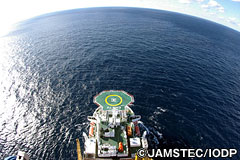
Distorted horizon makes it appear as if there is nothing but the Chikyu and the sea.
>>Expedition 316 Photo Gallery
Chikyu then relocated to Site NT1-03A (now renamed site C0007). The ROV was launched in order to deploy seafloor transponders below the Kuroshio Current (generally running at 2.0-2.5 knots), the HPCS/ESCS BHA was rigged up and readied while the vessel was calibrating for DPS navigation and positioning over the site. The BHA was run to the seafloor, and Hole C0007A was tagged at 22:30 PM on January 14th at a depth of 4081 mbsl, at location 33°01.23258’ N, 136°47.94852’ E.
The first core (316-C0007A-1H) was a successful mudline core that penetrated to 3.14 mbsf with 100% recovery. Due to operational and curatorial issues, the following core was labeled 316-C0007B-1H. This core was taken from 3.14 mbsf and it recovered 10.06 m of sediment with recovery of 105.9%. Because the bit came out of the borehole during recovery of this core, the following core was labeled 316-C0007C-1H. This core was taken from 12.64 mbsf and recovered 7.95 meters of sediment with 100% recovery.
All further coring was conducted in Hole C0007C continuously from this point. Cores 316-C0007C-2H to -4H, -5X to -15X, and -16H to -17H were collected with a total of 51.26 meters of recovery at a rate of 33.82% in interlayered silt, sand, etc. Jamming of the piston core barrel in the BHA following the shooting of core 316-C0007C-18H at ~15:00 PM on January 17th has required several hours of operational time.
Drilling at Site C0006 continued within the accretionary prism. The primary lithology was mudstone with volcanic ash layers. In general deformation was observed to be less than observed above, although several thrusts were inferred from the seismic interpretation. Because hole conditions prevented reaching the frontal thrust at Site C0006, an alternate location from the prospectus, NT1-03A, was selected to complete the objectives. Drilling was begun on Site C0007. Abundant sands have been observed (or inferred from poor recovery intervals) at this site.
Sampling for pore fluids, void gas (where appropriate), and head space gas was carried out in the core cutting area. XCT scanning, Multi-sensor core logging, and whole-round core sampling for geotechnical and physical properties analysis were carried out on whole round core sections, followed by core description (structural, sedimentological, stratigraphic), and physical properties measurements (thermal conductivity, moisture and density, P-wave velocity and electrical resistivity) were carried out on the split core section. This was followed by collection of a complete suite of samples for paleomagnetic, physical properties, paleontological, mineralogical, age-dating, geotechnical, and structural analyses. Following color and spectral scanning and paleomagnetic scanning, cores were packed for shipping to the core repository.

Weekly report #3
2008.1.11
IODP NanTroSEIZE Stage 1:
Expedition 316: NanTroSEIZE "Shallow Megasplay and Frontal Thrusts"
Weekly Report #3
Date 11/Jan/2008
Coring operations in Hole C0006E resulted in retrieval of Cores 37X-49X (286.8-409.4 meter below seafloor, or mbsf), with total recovery of 98.5 meters of core with recovery rate of 80.37%. After observing a drastically reduced rate of penetration, we determined that refusal had been reached, and Hole C0006E was completed at 409.4 mbsf, 19:30 PM on January 6. C0006E was completed, the Borehole Assembly pulled out of the hole, drill pipe tripped and the HPCS/ESCS Assembly was racked back.
Chikyu then relocated to Hole C0006F and the RCB Borehole Assembly was run down to the seafloor. Hole C0006F was tagged at 17:30 PM on January 7, at location 33° 1.6242’ N, 136° 47.6282’E, water depth 3875.5 meter. Conducted jet-in to 50 mbsf and washed down to 395 mbsf. RCB coring operations began, and since then cores C0006F-1R to13R have been collected from 395 to 514 mbsf for a total of 30.1 meters of recovery at a rate of 25%.
Drilling at Site C0006 continues within the accretionary prism; intensity of deformation is variable, and several generations of deformation have been observed. Possible repeated formations are consistent with stacking of thrust sheets, but currently biostratigraphy is unable to resolve any age reversals. The ESCS produced high recovery and was able to partially recover sand units. At ~400 mbsf, consolidation necessitated switching to RCB coring. Recovery using RCB has been lower and less representative of the formation; primarily more consolidated material is recovered.
Sampling for pore fluids, void gas (where appropriate), and head space gas was carried out in the core cutting area. XCT scanning, Multi-sensor core logging, and whole-round core sampling for geotechnical and physical properties analysis were carried out on whole round core sections, followed by core description (structural, sedimentological, stratigraphic), and physical properties measurements (thermal conductivity, moisture and density, P-wave velocity and electrical resistivity) were carried out on the split core section. This was followed by collection of a complete suite of samples for paleomagnetic, physical properties, paleontological, mineralogical, age-dating, geotechnical, and structural analyses. Following color and spectral scanning and paleomagnetic scanning, cores were packed for shipping to the core repository.

Weekly report #2
2008.1.4
IODP NanTroSEIZE Stage 1:
Expedition 316: NanTroSEIZE "Shallow Megasplay and Frontal Thrusts"
Weekly Report #2
Date 04/Jan/2008
Chikyu arrived on location at site C0006 (proposed NT1-03B) on December 27th and conducted tests of the underwater camera system, including untwisting the camera cable and tests of the camera system itself. Due to electronic problems, the camera operation test was cancelled at noon, December 28th.
The HPCS BHA (Hydraulic Piston Coring System Borehole Assembly) was rigged up and run to the seafloor at that time, and Hole C0006C was tagged at 19:15 PM December 28th. Due to full recovery and lack of a clear mudline, the vessel was repositioned, and Hole C0006D was tagged at 22:45 PM December 28th, again full recovery and lack of mudline required repositioning and reshooting. Hole C0006E was tagged at 00:00 (midnight) December 29th, with 5.19 meters of recovery including the mudline. HPCS coring with six APCT-3 temperature measurements was conducted to a depth of 79.3 meters below seafloor (mbsf). Refusal (no penetration) occurred on core C0006E-14H, and HPCS coring was halted.
Extended Shoe Coring (ESCS) commenced at that time, and has continued to the present, recovering 22 cores (C0006E-15X to 36X) with a total recovery of 138.8 meters, 66% recovery. Core quality has remained high throughout with some increase in coring-induced deformation in the lower section of the hole. Current depth is 286 meters below seafloor and ESCS coring is ongoing. During ESCS operations, the Davis-Villinger Temperature Probe has been deployed 6 times so far, at an interval of ~50 meters.
Repeated electrical troubles in the motor driving the lubrication system for the top drive forced several minor halts in drilling to wait for repairs. Identification of the source of these electrical failures (drilling fluid/seawater spray from the wireline blow-out preventer) allowed remediation and prevention, but has slowed the pace of coring operations. The wireline cable and sinker bar must be removed from the drill pipe before drilling begins and must be reinserted to recover core barrels, adding approximately 1 hour to each coring run.
Site C0006, proposed as Site NT1-03B, targets the main frontal thrust at the seaward edge of the accretionary wedge. The scientific objectives of drilling at Site C0006 are to clarify the function of the frontal thrust with respect to large earthquakes, the evolution of this thrust fault, and the relationship between fault slip and deformation. Drilling at this site has passed through slope deposits into the accretionary prism; however, the boundary between slope and prism sediments is not clearly defined. Poor recovery intervals may correlate with faults or sands tentatively identified in downhole logs during Expedition 314. Within the prism sediments, zones of deformation have been evidenced by the occurrence of shear bands and fractures. In situ temperature measurements are currently being evaluated.
Sampling for pore fluids, microbiology, void gas, head space gas, and imaging of cores for hydrate presence was carried out in the core cutting area. XCT scanning, Multi-sensor core logging, thermal conductivity measurement, and whole-round core sampling for geotechnical and physical properties analysis was carried out, followed by core description for structural, sedimentological and stratigraphic investigation. This was followed by collection of a complete suite of samples for paleomagnetic, physical properties, paleontological, mineralogical, age-dating, geotechnical, and structural analyses. Following color and spectral scanning and paleomagnetic scanning, cores were packed for shipping to the core repository.
Minor repairs and maintenance on several pieces of lab equipment have been carried out, with no major failures in any systems.

Weekly report #1
2007.12.27
IODP NanTroSEIZE Stage 1:
Expedition 316: NanTroSEIZE "Shallow Megasplay and Frontal Thrusts"
Weekly Report #1
Date 27/Dec/2007
The Expedition 316 began since December 19th immediately after the completion of previous cruise. Chikyu was on site and Hole C0004C was tagged at 5:35 AM December 20th.
Site C0004 is located along the slope of the accretionary prism landward of the inferred intersection of the megasplay fault zone with the seafloor. The purpose of drilling at this site is to core and sample the materials comprising the youngest sediments in the slope basin, material underlying these sediments (inferred to be older slope basin sediments overlying deformed and uplifted older accretionary prism material). The main target of the site is to core and sample across the megasplay fault zone at a depth of approximately 300 meters below seafloor (mbsf), and to core down to 400 mbsf in the underthrust materials identified in 3-D seismic interpretation.
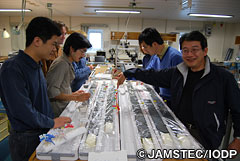
Sampling the unconformity, Shipboard scientists Tao Jiang, Yujin Kitamura, Arito Sakaguchi and Co-Chief Scientist, Gaku Kimura (Japan)
>>Expedition 316 Photo Gallery
Coring with HPCS (Hydraulic Piston Core Sampling System) commenced at that time and continued to a depth of 89.22 mbsf. Three APCT3 (Advanced Piston Corer Temperature) measurements were taken at the same time as collection of cores C0004C-3H, 6H, and 9H. ESCS (Extended Shoe Coring System) coring commenced at 22:13 on December 20th in Hole C0004C, and continued to a depth of 127.22 mbsf. Due to poor core quality, HPCS coring was resumed at 04:47 AM on December 21, and 3 cores (C0004C-16H-18H) were collected. The last HPCS (C0004C-18H, 133.18-135 mbsf) core also included an APCT3 run. At 07:32 AM on December 21, due to failure to achieve full penetration using the HPCS, the coring assembly and drill pipe was run out of the hole, and the hole was completed.
Repositioning to site C0004D began at 13:00 December 21, 2007, in parallel with making up the RCB assembly and running pipe to the seafloor. Hole C0004D was tagged at 00:30 December 22, 2007, and washing down to 100 mbsf commenced. RCB (Rotary Core Barrel) coring commenced at 12:25 December 22, 2007. During RCB coring, several instances of plugged bit throat and plugged bit nozzles were inferred from coring results and pressure readings, and bit de-plugging was conducted to clear the problem. Variations in RPM (revolutions per minute) and drilling fluid pressure/flow rate were used to attempt to improve recovery, and cleaning the bit by increasing flow after each core was implemented. Additionally, due to recovery problems, short cores were taken on every coring run below 238 mbsf (C0004D-21R).
TD of 400 mbsf was reached at 23:34 December 25th, POOH (pull out of hole) and completing the hole with high density fluid was carried out. Tripping the drill string and breaking down the bit assembly commenced.
Coring in holes C0004C and D recovered recent sediments from the slope basin deposits, crossed an unconformity into older slope sediments and then passed into the accretionary prism.
Core recovery was excellent during HPCS and ESCS coring, however the ESCS cores were determined to be too disturbed by drilling to meet the scientific needs of the expedition. Recovery was 100-105% in Hole C0004C, down to a depth of 135 mbsf. Core recovery during RCB operations was variable primarily due to the difficulty of rotary coring in highly fractured materials that make up the shallow accretionary prism. As a result of increasing lithification, combined with excellent work by the Core Technicians, Drillers, and Operations personnel, recovery in the lower section of Hole C0004D improved remarkably. Recovery between 100-242 mbsf ranged from 0-60%, averaging about 30% or less. Recovery between 242-400 mbsf ranged from 20-100% and averaged approximately 70%.
Based on limited recovery, the accretionary prism material is highly deformed and fractured. Near the base of the prism, two age reversals were crossed, indicating thrust faulting. These cores have been held back from splitting in preparation for detailed examination. Underthrust (younger) sediments exhibit decreasing deformation with depth below the splay fault system.
A program including piston coring, downhole temperature measurement, and rotary coring was designed to accomplish the coring, and a comprehensive sampling plan was developed to provide a full spectrum of scientific analyses of these materials. Sampling, description and measurement for interstitial pore water, microbiology, micropaleontology, mineralogy, sedimentology, structural geology, hydrological and geotechnical research, physical properties investigation, paleomagnetism, organic and inorganic chemistry of both solids and fluid were planned for all collected cores.
On December 26th, seafloor acoustic navigation beacons were recovered, the vessel was repositioned to site C0006C, and preparations for testing of the underwater television camera (for drilling at depths greater than 3000 meters water depth) commenced, and are underway as of the writing of this report.














